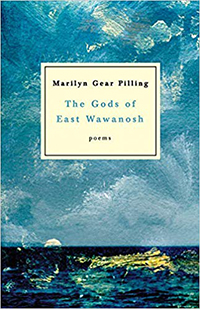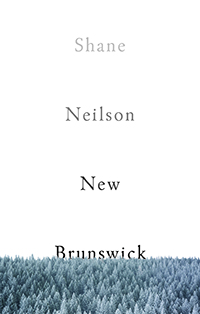Reviews
Poetry Reviews by Barbara Colebrook Peace
Marilyn Gear Pilling, The Gods of East Wawanosh(Toronto: Cormorant, 2019). Paperbound, 83 pp., $18.95.
Shane Neilson, New Brunswick (Windsor: Biblioasis, 2019). Paperbound, 87 pp., $19.95.
 Marilyn Gear Pilling’s The Gods of East Wawanosh is wise and deep. Infused with humanity, humour, and humility, the book’s words are rooted in the earth. Pilling writes out of a deep connection with the land where she grew up, East Wawanosh, Huron County, in poems that sing of the preciousness of creation and the uniqueness of each place. These poems hold a balance between grief and celebration. In “Community Picnic, 1954,” she evokes the way of life of the local region so vividly that the reader can feel what it’s like to walk in the river’s “warm golden water,” and taste the pies the women made “with lard at six a.m. when they could stand the wood stove on— / harvest apple, sour red cherry, raspberry.” We are so immersed in the sounds, tastes, and reality of the place that we feel the shock and deep grief of the poem’s ending: “No one knew then …”
Marilyn Gear Pilling’s The Gods of East Wawanosh is wise and deep. Infused with humanity, humour, and humility, the book’s words are rooted in the earth. Pilling writes out of a deep connection with the land where she grew up, East Wawanosh, Huron County, in poems that sing of the preciousness of creation and the uniqueness of each place. These poems hold a balance between grief and celebration. In “Community Picnic, 1954,” she evokes the way of life of the local region so vividly that the reader can feel what it’s like to walk in the river’s “warm golden water,” and taste the pies the women made “with lard at six a.m. when they could stand the wood stove on— / harvest apple, sour red cherry, raspberry.” We are so immersed in the sounds, tastes, and reality of the place that we feel the shock and deep grief of the poem’s ending: “No one knew then …”
that the end-of-summer gathering of East Wawanosh folk,
as well as the gods who both
shattered and held the world together, would die before we did.
A major theme of the book is the tension between that shock when something is gone for good and the wonder that life sometimes, miraculously, holds on. One of my favourite poems of the collection, “Still,” embodies this:
Mother. I want you to know
that you can still see Huron’s stripe of dark blue
from the top of Carlow Hill ….
Characteristic of Pilling’s finest work, this poem shows her close observation of the natural world, her appeal to all the senses, and her craft. She uses the word “still” thirteen times within twenty-one lines, playing on the double sense of continuance and calmness. By varying the placement in the line of the word “still,” she conveys how life can marvellously persevere, popping up seemingly against all odds. In poem after poem, she gives examples of creatures holding onto life, however tenuous and fragile. It might be a human being such as herself, arguing with her sister for the preservation of their old home, or a man with a heart transplant in a swimming pool, “Sometimes I feel the lost lives here, / while I’m swimming,” or it might be another creature, “Mange with its torturing itch / has destroyed his fur all the way to his haunches … // I see with disbelief that he is grooming himself.”
Care for other creatures permeates this collection, beginning early in childhood where the poet and her brother visit a natural swimming hole on summer afternoons: “Unique / smell of creek life / that stayed in our hair / water spiders, crayfish / stonefish, families of leaves….” This swimming hole is a shared community where she and her brother listened to the smaller beings, “heard their stories / told them ours.” Such attentive listening to the stories of others is intrinsic to the whole book, and what Pilling celebrates is the small things in the finest detail. Not just porridge, but “the cold leavings of yesterday’s / porridge”; not just “creek life,” but “water spider, crayfish….” These small, lovingly observed and felt details contribute to the book’s sense of being fully present and at home on the earth.
Free from pretence, Marilyn Gear Pilling’s writing sounds completely natural and unforced. Her vision looks downwards as well as up at the sky, a vision that comprehends Chiclets gum, rubber boots, a worm, the hard-packed earth of the cellar floor. A sense of the sacredness of the land, its blessing, extends in her compassion even to a grandfather leaving his wife and young son, his feet “damp with April melt.” This book welcomes me as reader onto its back porch, and I know I will re-enter it many times.
 In his beautiful and haunting new collection of poems, New Brunswick, Shane Neilson explores the nature of his home province with the same deeply searching spirit he has hitherto brought to the subjects of pain and identity. He has made the book so personally moving and engaging that he draws the reader into this exploration with him. The book is dedicated to “the New Brunswicks of” each of his parents, and the curious use of the plural “Brunswicks” hints that each person has known the province differently, and also that the life of New Brunswick will be presented as inextricably interwoven with that of his parents and indeed with his own childhood. Reflective, lyrical, grief-filled, and unsettling by turns, this book is full of interrogatives, especially “why,” “what,” and “where,” and statements transformed into questions by simply adding a question mark, implying there is a continuous dialogue within the narrator’s mind. The poet questions himself, each of his parents, and a “New Brunswick” which is personified not as a human body but rather as a felt collective consciousness. This “New Brunswick” has a voice, in the opening and closing poems “Pass By” and “New Brunswick Answers,” becoming the book’s alpha and omega.
In his beautiful and haunting new collection of poems, New Brunswick, Shane Neilson explores the nature of his home province with the same deeply searching spirit he has hitherto brought to the subjects of pain and identity. He has made the book so personally moving and engaging that he draws the reader into this exploration with him. The book is dedicated to “the New Brunswicks of” each of his parents, and the curious use of the plural “Brunswicks” hints that each person has known the province differently, and also that the life of New Brunswick will be presented as inextricably interwoven with that of his parents and indeed with his own childhood. Reflective, lyrical, grief-filled, and unsettling by turns, this book is full of interrogatives, especially “why,” “what,” and “where,” and statements transformed into questions by simply adding a question mark, implying there is a continuous dialogue within the narrator’s mind. The poet questions himself, each of his parents, and a “New Brunswick” which is personified not as a human body but rather as a felt collective consciousness. This “New Brunswick” has a voice, in the opening and closing poems “Pass By” and “New Brunswick Answers,” becoming the book’s alpha and omega.
One of my favourite poems in the collection, “My Daughter Imitates A.Y. Jackson’s ‘Road to Baie St. Paul,’” is what I would call meta-ekphrastic, because it is about a painting that imitates a painting. Within that doubled image, the poet reflects not only on the original work of art and how it speaks to him of place, but also on his daughter’s painting and what he sees and feels in it:
… My daughter
built this place with its limited range,
let the structures collapse and lean, the ache
of unseen men and women held in their places
and homes,…
He identifies what is mysteriously left out of her painting, and continues to question, musing about the man who appears: “Who could it be, and where is this, / and why? I think I’ve lived there all my life….” The poem’s ending is extraordinarily moving:
Take heart,
I tell the man, and Hurry. Find them,
make sure they are inside.
One of the things I like best about the book is its complex music as Neilson moves from one long poem to another. There is an excellent use of form, such as pantoum, villanelle, substitution poem, and sonnet corona, but what I especially appreciate is where, within a long-poem sequence, he breaks the pattern unpredictably to suggest a spilling over, a refusal to be contained, and a contradiction of orthodox belief. He links the six sections of the book into one long choral or symphonic work with repetition of key words and phrases, refrains, and recurring imagery. Sometimes he uses the official symbols of the province—golden lions, purple violets, a galley known as the Lymphad—and transforms them powerfully. Spanning the book’s narrative arc, the Lymphad first appears near the book’s beginning in the long poem “New Brunswick: A Timeline Legend,” in the image of a little girl who “sleeps sound on the midnight-white Lymphad.” At the book’s end, the Lymphad recurs in the long poem “Loss Sonnets,” becoming a ghost ship on the river Lethe which his mother sails in dying. The poet links these two images, hinting that the dying woman becomes once more a girl, or that she exists, in an alternative timeline, as one continuous being: “In the basket, the maid’s breath plumes / as a banner of gold.”
As one who knew little of New Brunswick before, I found this book fascinating, challenging, and transformative. Reading it has deepened my understanding, as an immigrant, of Canada. It has also widened my understanding of what it means to be human.
—Barbara Colebrook Peace









